de Nicaragua
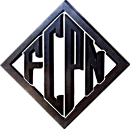
F.C.P.N.
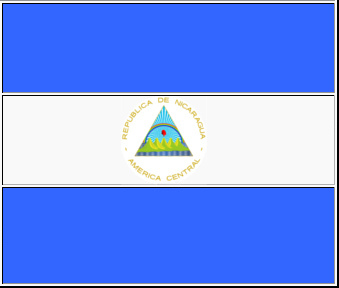
de Nicaragua
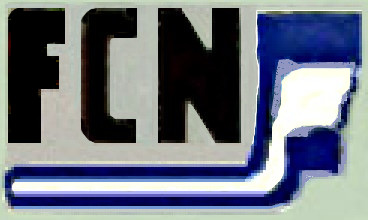
F.C.N.
| Central America | |||||||||
| Ferrocarril | Nicaragua | Railroad | |||||||
| nicatrenes.com | |||||||||
| Acerca de Nosotros | About US |
| Ferrocaril del Pacifico de Nicaragua  F.C.P.N. |  | Ferrocaril de Nicaragua  F.C.N. |
| Español; Acerca de Nosotros | English; About us |
| Este sitio-web comenzo el 1 de Enero de 2015. Este será el primer sitio web bilingüe dedicado a todos los ferrocarriles de Nicaragua, (Español y Inglés). Muchas fotos, información, un blog, y enlaces a otros sitios del Internet, seguirán en breve. Por favor ser paciente conmigo, que estoy aprendiendo a construir un sitio del Internet. Quizás en el futuro, pude representar a todos los transportes Nicaragüenses - Aviones, Barcos y la historia del "Canal Inter-Oceano" en Latino America. | This website was started on January 1, 2015. This will be the first bilingual website dedicated to all of Nicaragua's Railroads. (Spanish and English). Many Pictures, Information, Links to other websites and a blog will follow shortly. Please bare with me, I am learning how-to create a website! Maybe in the future all Nicaraguan transportation will be included, For example: Planes, Ships and the history of the "Inter-Ocean Canal" in Latin America. |
| Español; Por favor no dude en ponerse en contacto con nosotros! Correo electrónico = nicatrenes@gmail.com Y Por Facebook = facebook.com/NicaraguaTrenes | |
| English; Please feel free to contact us! Email = nicatrenes@gmail.com ALSO By Facebook = facebook.com/NicaraguaTrenes | |
| Español; |
| Nuestra Dirección en Internet |
| La dirección de Internet es; nicaraguarailroadhistory.com Estos son dos nombres cortos que le llevarán a nuestra página de inicio; nicatrenes.com Y nicaraguaferrocarril.com |
| English; | |
| Our Address on the Internet | |
| The web-address is; nicaraguarailroadhistory.com These are two short names which will bring you to our home page; nicatrenes.com OR nicaraguaferrocarril.com | |
| Locomotora No.38 | Locomotive No.38 |
| Locomotora No.38 Nombre de locomotora; León "Ferrocarril del Pacifico de Nicaragua" (F. C. del P. de N.) (FCPN) / Esto es una foto de la fábrica en Alemania, de la Locomotora No.38, recién construido en el año 1954. / Los lugareños apodaron a estas locomotoras alemanas "Chocoyas", por los colores con los que estaban pintadas". ("Chocoyas" = mujer-periquitos) / Locomotora No.38 Fabrica; "Henschel", de Alemania. Tipo de Energía; Vapor Fecha de construcción; 1954 Numero de construcción; c/n #25669 Arreglo de Rueda; 2-8-2 Ancho de via; 3 pies y 6 pulg (1.067 mm) / La foto; Es de nicosplit.com - Nico graciosamente permitió que nosotros lo usáramos. | Locomotive No.38 Locomotive name; Leon F. C. del P. de N. (FCPN) ("Ferrocarril del Pacifico de Nicaragua") / This is a factory photo of locomotive No.38, newly constructed at the factory in Germany. / The locals nicknamed these steam locomotives "Chocoyas" (female-parakeets), because of the colors they were painted." / Locomotive No.38 Manufacturer; "Henschel", of Germany. Power Type; Steam Build date; 1954 Build Number; c/n #25669 Wheel Arrangement; 2-8-2 Narrow Gauge; 3 ft 6 in (1.067 mm) / This factory photo of Locomotive No.38 is from from nicosplit.com, Nico graciously allowed us to use it |
| Aquí están algunos de mis estudios: | These are some of my studies: |
| En el año 2013 y en 2017; visité el país de Nicaragua y fui al; “Instituto de Historia de Nicaragua y Centroamérica” - “Universidad Centroamericana” - “UCA” Aquí miré los documentos originales desde los 1800's hasta la actualidad. Logré obtener alrededor de 100 fotos de los archivos de la UCA, la mayoría de las cuales nunca se habían publicado en Internet. / Estas fotos son reproducidas de las negativas originales. | In 2013 and 2017; I visited the country of Nicaragua and I went to; "Instituto de Historia de Nicaragua y Centroamérica" -"Universidad Centroamericana UCA" Here I looked up the original documents from the late 1800's to the present. I acquired about 100 pictures from UCA archives, most of which have never been published on the internet before! / These photos are reproduced from the original negatives. |
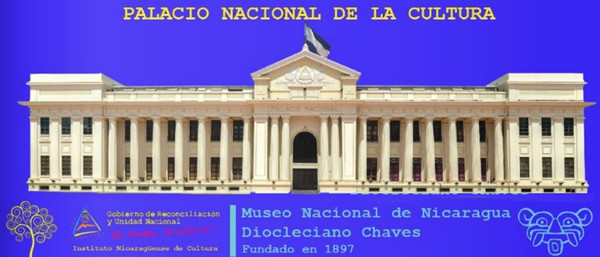 | |
| En 2017 visité el "Palacio Nacional" en Managua, Nicaragua. Estudié en su archivo durante 6 meses. Aquí miré miles de documentos originales que datan del año 1900 hasta el final del ferrocarril. | In 2017 I visited the "Palacio Nacional" in Managua, Nicaragua. I studied at their archive for 6 months. Here I looked at thousands of original documents dating from 1900 till the final end of the railroad. |
| Locomotora No.31 Esta es una de las fotografías que he adquirido de los archivos de la “Instituto de Historia de Nicaragua y Centroamérica” - “Universidad Centroamericana” - “UCA”. ¡Esta foto fue publicada por primera vez en el internet, por mí, en este sitio web! | Locomotora No.31 This is one of the photos that I purchsced from the “Instituto de Historia de Nicaragua y Centroamérica” - “Universidad Centroamericana” - “UCA”. We were the first to published this original photo on the internet, on this website! |
| Locomotora No.31 F. C. del P. de N. (FCPN) ("Ferrocarril del Pacifico de Nicaragua") / Foto tomada en los talleres del ferrocarril de Managua, Los talleres del ferrocarril llevan el nombre de "Escuela de Arte". / En el año 1938, Nicaragua adquirió esta locomotora No.31, en estado usado, del país de Costa Rica. / Locomotora No.31 Fabrica; Baldwin, Tipo de Energía; Vapor Fecha de construcción; 08/1926 Numero de construcción; c/n #59402 Arreglo de Rueda; 2-8-0 Ancho de via; 3 pies y 6 pulg (1.067 mm) | Locomotive No.31 F. C. del P. de N. (FCPN) ("Ferrocarril del Pacifico de Nicaragua") / Photographed at the Managua railroad shops, The railroad shops go by the name; “Escuela de Arte”. / In the year 1938, Nicaragua acquired this locomotive No.31, in used condition, from Costa Rica. / Locomotive No.31 Manufacturer; Baldwin, Power Type; Steam Build date; 08/1926 Build Number; c/n #59402 Wheel Arrangement; 2-8-0 Narrow Gauge; 3 ft 6 in (1.067 mm) |
 | |
| He estudiado la: "Biblioteca DeGolyer, Universidad Metodista del Sur" Archivos para; Las especificaciones de los locomotores de "Baldwin Locomotive Works" | I studied the: "DeGolyer Library, Southern Methodist University" Archives for; "Baldwin Locomotive Works" engine specifications |
| LIBROS y ARTÍCULOS que he leído: | BOOKS and ARTICLES I have read: |
| "El Ferrocarril de Nicaragua - Historia y Liquidación" 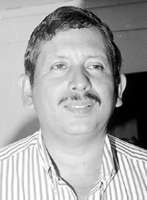 Foto del Autor; Orient Bolívar Juárez / (Me encontré con Orient Bolívar una vez, brevemente en 2013 en Nicaragua) NOTA; Creo que este es el mejor libro para entender la historia completa del Ferrocarril de Nicaragua. Desde su inicio hasta su final. | "El Ferrocarril de Nicaragua - Historia y Liquidación" (pub. 1997)  Photo of Author; Orient Bolívar Juárez / I met with Orient Bolívar briefly in 2013 in Nicaragua. NOTE; I believe this is the best book to understand the complete history of the Nicaragua Railroad. From its beginning to its end. |
| "Un Siglo Sobre Rieles - El Ferrocarril en Nicaragua" (pub. 1977) / (Esto es un libro muy escaso, tuve que enviar mi copia desde Perú.) 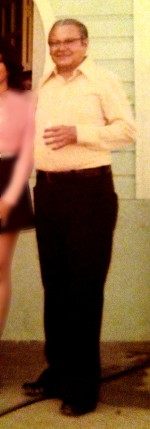 Foto del Autor; Eduardo Perez – Valle. Foto del Autor donada por; Gelmi Arrieta. | "Un Siglo Sobre Rieles - El Ferrocarril en Nicaragua" (pub. 1977) / (This is a very rare book, I had to purchase mine from Peru and have them ship it to me.)  Photo of Author; Eduardo Perez – Valle Author's Photograph donated by; Gelmi Arrieta. |
| "Revista de la Academia de Geografia e Historia de Nicaragua" (pub. 1947) / "Los Ferrocarriles en Nicaragua" / Autor; Sofonias Salvatatierra / (Nota: La información utilizada para este artículo fue obtenida de los documentos originales). | "Revista de la Academia de Geografia e Historia de Nicaragua” (pub. 1947) / “Los Ferrocarriles en Nicaragua" / Author; Sofonias Salvatatierra / (Note: The information used for this article “Los Ferrocarriles en Nicaragua” was gleaned from the original documents.) |
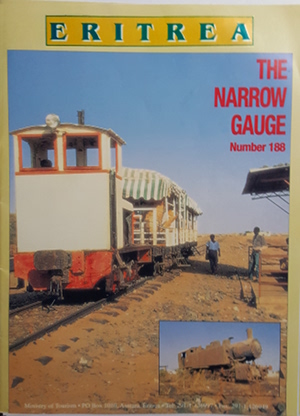 | |
| Artículo; "The Railways of Nicaragua", De la Revista; The Narrow Gage Magazine Número 188, Pub; Primavera 2005. Autor; Richard Yudin | "Magazine article; "The Railways of Nicaragua", Magazine; The Narrow Gage Magazine Number 188, Pub; Spring 2005. Author; Richard Yudin |
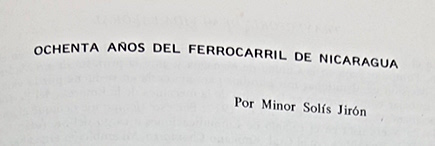 | |
| Artículo de ochenta páginas; "Ochenta años del Ferrocarril de Nicaragua" Autor; Minor Solís Jirón Pub; del Banco Central, (después del año 1977) | Eighty page article; "Eighty years of Nicaragua's railroad" Autor; Minor Solís Jirón Pub; by Banco Central, (after the year 1977) |
| ACERCA DE MI | ABOUT ME |
| Esta es una foto de mí (Norman) y mi esposa en Nicaragua en 2013. | This is a photo of me (Norman) and my wife in Nicaragua in 2013. |
| Mi nombre es Norman. Soy el propietario de este sitio web, que se dedica a la historia de los ferrocarriles de Nicaragua. / Nací y me crié en Estados Unidos. / Mi lengua materna es el inglés americano, Hablo español como latino de segunda generación nacido en el extranjero. / Yo tengo que usar traductores de internet para escribir en Español. Ahora estoy utilizando casi exclusivamente el traductor deepl.com , pero empecé con spanishdic.com . / Soy un entusiasta sobre la Historia de los Ferrocarrils. / Mi madre y mi esposa son nicaragüense, por lo tanto mi interés por la historia del Ferrocarril de Nicaragua. | My name is Norman. I am the owner of this website, which is devoted to the history of the railroads of Nicaragua. / I was born and bred in the USA. / My native language is American English, I speak Spanish as a second generation Latino born abroad. / I have to use an internet translater to write in Spanish. I am now almost exclusively using the translator deepl.com , but I began with spanishdic.com . / I am a Railroad-History–Enthusiast. / My mother and wife are Nicaraguan, from there comes my interest in Nicaragua's Railroad history. |
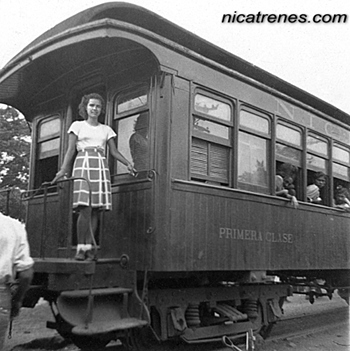 | |
| Mi madre en un vagón de pasajeros de primera clase antes de 1940. "Ferrocarril del Pacífico de Nicaragua" (F.C. del P. de N.) | My mother on a first class passenger car before 1940. "Ferrocarril del Pacifico de Nicaragua" (F.C. del P. de N.) |
| Cronología; Por qué comencé este sitio web | Chronology; Why I started this website |
| EN EL AÑO 2001 | IN THE YEAR 2001 |
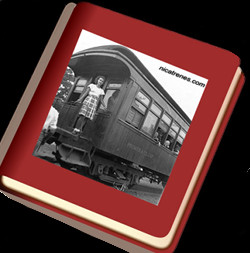 | |
| En el año 2001, leí el libro; "El Ferrocarril de Nicaragua – Historia y Liquidación" Escrito por Orient Bolívar Juárez pub.1997), Después de leer el libro de Orient Bolívar, sentí la necesidad de escribir un libro en inglés, dedicado a los Ferrocarriles de Nicaragua, Para que los Aficionados al Ferrocarril, que sólo entienden el inglés, puedan experimentar el carácter especial y único de los ferrocarriles de Nicaragua. **En el año 2001; Comencé mis estudios sobre el Ferrocarril de Nicaragua en serio, con el intención de escribir un libro en inglés. | Back in the year 2001, I read the book; “El Ferrocarril de Nicaragua - Historia y Liquidación” written by Orient Bolívar Juárez pub.1997 After reading Orient Bolívar's book, I felt the need to write a book in English, dedicated to Nicaragua's Railroads, So the Railroad Enthusiast, whom only understand English, could experience the special unique character of Nicaragua's Railroads. ***In the year 2001; I began my Nicaragua Railroad studies in earnest, with the intention of writing a book in English. |
| 2005 | |
| En el año 2005; Empecé a tener el deseo de crear una presencia en el internet, dedicada a los ferrocarriles de Nicaragua. Después de varios intentos, me di cuenta de que crear un sitio-web era demasiado abrumadora para mí (demasiadas cosas para aprender para hacer un sitio web). | In the year 2005; I began to have the desire to create an internet presence dedicated to the Nicaraguan railroads. After several attempts, I realized that creating a website was too overwhelming for me (too many things to learn to make a website). |
| 2007 | |
| A
partir del año 2007 hasta el 2013, me puse muy enfermo y abandoné todos
mis Proyectos. ¡Incluso dejé de ver el internet! *(ver la *Nota2 abajo, al pie de la página; para una explicación, de lo que hice para recuperarme.) | Begining
in the year 2007 till 2013, I became very sick and abandoned all my
projects. I even stopped looking at the internet! *(See the footnote *Note2 at the bottom of this page: for an explanation of what I did to recover.) |
| EN EL AÑO 2013 | IN THE YEAR 2013 |
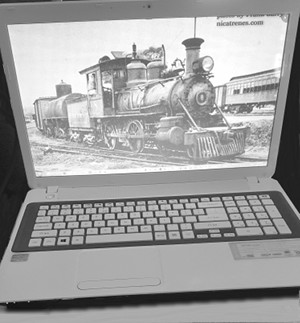 | |
| Español; | |
| A
mediados del año de 2013, (poco después de recuperar mi salud); comencé a buscar en internet nuevamente información, referente a los ferrocarriles de Nicaragua. / Entonces me di cuenta de que; 1) Todavía había un solo sitio web escrito en inglés, dedicado a los ferrocarriles de Nicaragua. El único sitio web escrito en inglés era; Fahrplancenter.com (Fahrplancenter estaba en Internet, desde que empecé a buscar en 2001). 2) Los sitios web en español tenían un alcance muy limitado. Carecían de los detalles adicionales que los entusiastas del ferrocarril anhelan (experiencias personales, fotos detalladas y documentación histórica). 3) Nadie, ni español, ni inglés, a excepción de -Sólo uno de cada cien comentarios en los blogs, incluían enlaces de Internet, o el reconocimiento de donde originalmente encontraron la información. (una necesidad para verificar la exactitud de la información) 4) La información del ferrocarril de Nicaragua todavía era dispersa por todo partes del Internet, incluso escondidos en lugares inesperados. | |
| English; | |
In the middle of 2013 (soon after recovering my health); I began to look on the internet again for information, pertaining to Nicaragua's railroads. / At that time, I realized; 1) There was still only one website written in English, dedicated to Nicaragua's Railroads. The only website written in English was; Fahrplancenter.com (Fahrplancenter was on the internet, from when I started searching in 2001.) 2) The Spanish-websites were very limited in scope. They lacked the extra details, that railroad enthusiast long for (personal experiences, detailed photos and historical documentation!) 3) Nobody, neither Spanish, nor English, with the exception of -Only one out of a hundred blog post, were including internet-links, or recognition to where they originally found the information. (a necessity to verify the accuracy of information) 4) Nicaragua's Railroad information was still scattered all over the internet, even hidden in many unlikely places. | |
 | |
| 5) Hay demasiada información errónea, que no es coincidente con los documentos originales. Por ejemplo; la información acerca de las razones por las que el antiguo "Ferocarril de Nicaragua" (FCN) fue cerrado y liquidado. Muchas de las respuestas presentadas para el cierre y la liquidación del ferrocarril; Se impulsan sobre todo por las intensas opiniones políticas de los individuos, ¡con el deseo de insultar! En lugar de expresar los hechos o querer aprender. / *(Consulte la *Nota1 al final de esta página para ver las fuentes, donde encontrará, las razones por las que se cerró el ferrocarril, donde se ha documentado y explicado). | 5) There is too much erroneous information, which is not consistent with the original documents. For example; The information concerning the reasons why the former “Ferocarril de Nicaragua” (FCN) was closed and liqudated. Many of the responses presented for the closing and liquidation of the railroad; Are mostly driven by the intense political opinions of individuals, with the desire to insult! Rather than expressing the facts or wanting learn. / *(See *Note1 at the bottom of this page for a source, where you will find, the reasons why the railroad was closed, where it has been documented and explained.) |
| EN EL AÑO 2014 | IN THE YEAR 2014 |
| Decidí
que la mejor manera de repartir la información sobre el ferrocarril de
Nicaragua para que fuera accesible a todo el mundo era crear un sitio
web bilingüe (español e inglés). Este sitio web sería donde se presentaría la información de los Ferrocarrils de Nicaragua, con sus pruebas fácticas, incluyendo el enlace o lugar correspondiente donde se encontró. | I
decided the best way to spread, Nicaragua's Railroad information so it
would be accessible, to the whole world, was to create a bilingual
website, (Spanish and English). This website would be where information for the Nicaraguan Railroads would be presented, with its factual evidence, including the corresponding link or location were it was found. |
| SIN EMBARGO, tendré que depender en gran medida de la información ferroviaria de los supervivientes y de las historias contadas por sus familias, ya que la mayoría de los documentos históricos del ferrocarril fueron destruidos. | HOWEVER;
I will have to rely heavily on the railroad information of survivors
and the stories told by their families, since most of the railroad's
historical documents were destroyed. |
| El autor "Orient Bolívar Juárez" del libro "El Ferrocarril de Nicaragua - Historia y Liquidación" me dijo que la mayoría de los documentos fueron enviados para ser reciclados en productos de papel. | The author “Orient Bolívar Juárez” of the book "El Ferrocarril de Nicaragua - Historia y Liquidación" told to me that most of documents were sent to be recycled into paper products. |
| Hablé con personas que intentaron rescatar los documentos originales del ferrocarril, me explicaron; Era muy difícil salvar los documentos del ferrocarril. Estaban abandonados, tirados por todas partes en las oficinas y almacenes, lo que dificultaba encontrar los que son importantes. Además, la mayoría de los documentos estaban contaminados por el agua y los elementos y no podían ser rescatados. | I talked to people who tried to rescue the original railroad documents, they explained; It was very difficult to save the railroad documents. they were left abandoned, strewn everywhere in the offices and warehouses which made it difficult to find the important ones. Also most of documents had been contaminated by water and the elements and could not be salvaged. |
| Estación Ferroviaria de León. Fotógrafo; Michael Fuery Fecha; Agosto de 1986 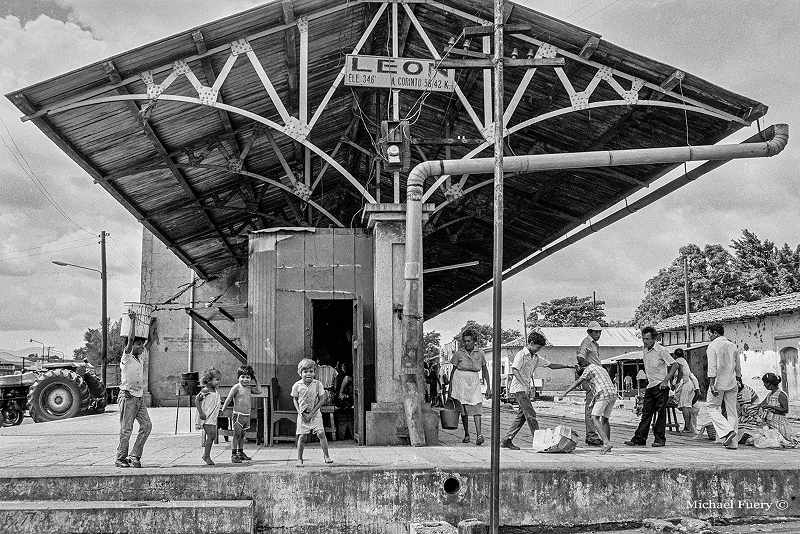 León Railway Station. Photographer; Michael Fuery Date; August of 1986 | |
| 2015; ¡Yo empecé este sitio en el Internet! | 2015; I started this website! |
| nicatrenes.com nicaraguarailroadhistory.com | |
| ¡El primero de enero de 2015; comencé este sitio del interne ¡Comencé a aprender a construir un sitio web el día anterior! (Ya no era necesario aprender código de computadora). Yo estoy procediendo a construir este sitio-web con la filosofía; ¿Cómo se come un elefante? -- Respuesta: un bocado a la vez! ¡Debo introducir esta filosofía con; ¡debes dar el siguiente paso adecuado (bocado)!" Primero debe encontrar el siguiente paso adecuado; Por ejemplo, un primer paso adecuado es; cocinar el pollo antes de comerlo. o ponerse los calcetines antes que los zapatos. ¡Este sitio web es un gran elefante! Este sitio tendrá al menos cien páginas web y también será bilingüe (español e inglés). | On January 1, 2015; I started this website I started learning how to build a website on the day before! (It was no longer necessary to learn computer code!) I am proceeding to build this website with the philosophy; How do you eat an elephant? -- Answer: One bite at a time! I must preface that philosophy with "you must take the proper next step (bite)!" You must first find the proper next step; For example a proper first step is; cook the chicken before you eat it. or put the socks on before the shoes. This website is a big elephant! This site will have at least one hundred web-pages and it will also be bilingual (Spanish & English). |
| *Nota1; Las razones por las que se cerró el ferrocarril | *Note1; Reasons why the railroad was closed |
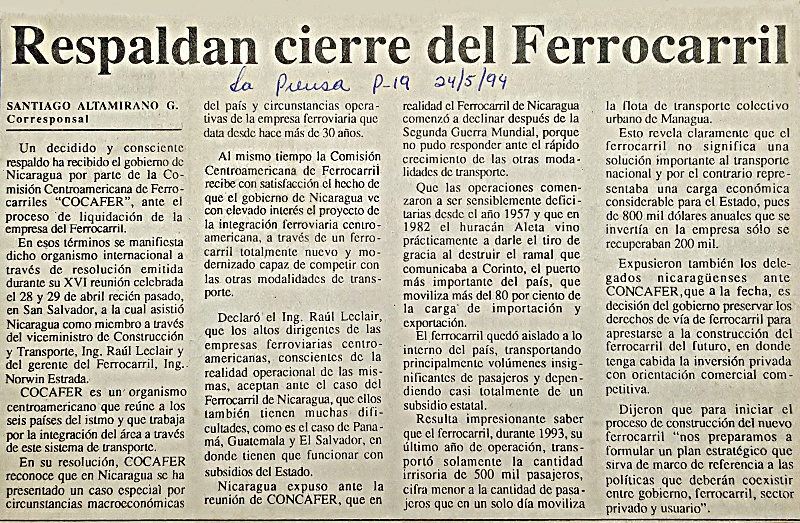 | |
| *Nota1; Título: Respaldan cierre del Ferrocarril Fuente; "La Prensa" periódico del 24 de abril de 1994 Autor; "Santiago Altamirano G." Cita directa; Un decidido y consciente respaldo ha recibido el gobierno de Nicaragua por parte de la "Comisión Centroamericana de Ferrocarriles" COCAFER ante el proceso de liquidación de la empresa del Ferrocarril. / En esos términos se manifiesta dicho organismo internacional a través de resolución emitida durante su XVI reunión celebrada el 28 y 29 de abril recién pasado, en San salvador, a la cual asistió Nicaragua como miembro a través del "Viceministro de Construcción y Transporte", Ing. Raúl Leclair y del "Gerente del Ferrocarril", Ing. Norwin Estrada. / COCAFER es un organismo centroamericano que reúne a los seis países del istmo y que trabaja por la integración del área a traes de este sistema de transporte. / En su resolución, COCAFER reconoce que en Nicaragua se ha presentado un caso especial por circunstancias macroeconómicas del país y circunstancias operativas de la empresa ferroviaria que data desde hace mas de 30 anos. / Al Mismo tiempo la Comisión Centroamericana de Ferrocarril recibe con satisfacción el hecho de que el gobierno de Nicaragua ve con elevado interés el proyecto de la integración ferroviaria centroamericana, a través de un ferrocarril totalmente nuevo y modernizado capaz de competir con las otras modalidades de transporte. / Declaro el Ing. Raúl Leclair, que los altos dirigentes de las empresas ferroviarias centroamericanas, conscientes de realidad operacional de las mismas, aceptan ante el caso del Ferrocarril de Nicaragua, que ellos también tienen muchas dificultades, como es caso de Panamá, Guatemala y El Salvador, en donde tienen que funcionar con subsidios del Estado. / Nicaragua expuso ante la reunión de COCAFER, que en realidad el Ferrocarril de Nicaragua comenzó a declinar después de la Segunda Guerra Mundial, porque no pudo responder ante el rápido crecimiento de las otras modalidades de transporte. / Que las operaciones comenzaron a ser sensiblemente deficitarias desde el año 1957 y que en 1982 el huracán Aleta vino prácticamente a darle el tiro de gracia al destruir el ramal que comunicaba a Corinto, el puerto más importante del país, que moviliza más del 80 por ciento de la carga de importación y exportación. / El ferrocarril quedo aislado a lo interno del país, transportando principalmente volúmenes insignificante de pasajeros y dependiendo casi totalmente de un subsidio estatal. / Resulta impresionante saber que el ferrocarril, durante 1993, su último año de operación, transportó solamente la cantidad irrisoria de 500 mil pasajeros, cifra menor a la cantidad de pasajeros, que en un solo día moviliza la flota de transporte colectivo urbano de Managua. (Nota; 500.000/año = 1370/día) / Esto revela claramente que el ferrocarril no significa una solución importante al transporte nacional y por el contrario representa una carga económica considerable para el Estado, pues de 800 mil dólares anuales que se invertía en la empresa solo se recuperaban 200 mil. / Expusieron también los delegados nicaragüenses ante COCAFER, que a la fecha, es decisión del gobierno preservar los derechos de la vía de ferrocarril para aprestarse a la construcción del ferrocarril del futuro, en donde tenga cabida la inversión privada con orientación comercial competitiva. / Expusieron también los delegados nicaragüenses ante COCAFER, que a la fecha, es decisión del gobierno preservar los derechos de la vía de ferrocarril para aprestarse a la construcción del ferrocarril del futuro, en donde tenga cabida la inversión privada con orientación comercial competitiva. / Dijeron que para iniciar el proceso de construcción del nuevo ferrocarril nos preparamos a formular un plan estratégico que sirva de marco de referencia a las políticas que deberán coexistir entre gobierno, ferrocarril, sector privado y usuario. FIN Nota de nicatrenes; Huracán Aletta En el año 1982, durante el período del 20 al 31 de mayo, el huracán Aletta descargó un total de 54,5 pulgadas de lluvia en Nicaragua. La lluvia provocó inundaciones que destruyeron completamente dieciocho kilómetros de ferrocarril y 9 puentes. (Sesenta mil personas se quedaron sin hogar) | *Note1; Title; Railroad closure supported Source; "La Prensa" Newspaper dated April 24, 1994 Author; "Santiago Altamirano G." Direct quote; Translated from Spanish The Nicaraguan government has received strong and conscious support from the "Central American Railroad Commission" COCAFER regarding the process of liquidation of the Railroad Company. "Comisión Centroamericana de Ferrocarriles" / In those words it was stated by the aforementioned international organization COCAFER via a resolution issued during its XVI meeting held on April 28 and 29 of last year (1993) in San Salvador, in which Nicaragua attended as a member, represented by its; "Vice Minister of Construction and Transportation" Engineer Raúl Leclair and also by its "Railroad Manager" Engineer Norwin Estrada. / COCAFER is a Central American organization that brings together the six countries of the isthmus (Central America) and works for the integration of the area through this transportation system. / In its resolution, COCAFER recognizes that Nicaragua has presented a special case due to macroeconomic circumstances of the country and operational circumstances of the railway company, circumstances which began to manifest from more than 30 years ago. / At the same time, the "Central American Railroad Commission" welcomes the fact that the Nicaraguan government is very interested in the Central American railroad integration project, by means of a totally new and modernized railroad capable of competing with other modes of transportation. / Raul Leclair stated that the top leadership of the Central American railroad companies, aware of their own operational situations, agree that in the case of the Nicaraguan Railroad, they also have many difficulties, as is the case in Panama, Guatemala and El Salvador, where they must operate with subsidies from the State. / Nicaragua explained before the COCAFER meeting that the Nicaraguan Railroad actually began to decline after the Second World War because it was not able to deal with the rapid growth of other modes of transportation. / Operations began to be significantly unprofitable from the year 1957 and in 1982 Hurricane Aletta practically gave it the death blow by destroying the branch line that connected to Corinto, the country's most important port, which mobilizes more than 80 percent of the import and export cargo. / The railroad was left stranded, inside the interior of the country, transporting mainly small numbers of passengers and depending almost entirely on state subsidy. / It is interesting to note that the railroad, during 1993, its last year of operation, transported only a low number of 500,000 passengers, a total less than the number of passengers carried in a single day, by the city of Managua's urban mass transit fleet. (Note; 500,000/year = 1370/day) / This clearly reveals that the railroad does not represent an important solution to national transportation and, on the contrary, it represents a considerable economic burden for the State, since out of the 800 thousand dollars invested annually in the company, only 200 thousand dollars were recovered. / The Nicaraguan delegates who attended COCAFER also stated that at present, it is the government's decision to preserve the rights to the railroad's right-of-way in order to prepare for the construction of the railroad of the future, where there will be room for private investment oriented towards being commercially competitive. / They said that to begin the process of building the new railroad, we are preparing to formulate a strategic plan which will serve as a frame of reference for the policies that must coexist between the government, the railroad, the private sector and the user. END Note by nicatrenes; Hurricane Aletta In 1982, during the period from May 20 to 31, Hurricane Aletta dumped a total of 54.5 inches of rain in Nicaragua. The rain provoked floods which completely destroyed eighteen kilometers of railroad and 9 bridges. (Sixty thousand people were left homeless) |
| *Nota1; continuación | *Note1; continued |
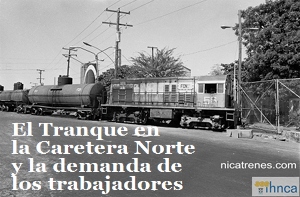 | |
| *Nota1; Un fuente adonde encontraron informacióna documentando de la cierre del ferrocarril es en el libro: "El Ferrocarril de Nicaragua – Historia y Liquidación" Escrito por Orient Bolívar Juárez (pub.1997). Refiérase a las páginas siguientes; 4. "El itinerario de la crisis final del Ferrocarril" páginas 81 al 84, 5. El cierre definitivo del Ferrocarril" * 5a. "La suspensión de los trabajadores" páginas 84 al 86, * 5b. "El Tranque en la Caretera Norte y la demanda de los trabajadores" página 86, | *Note1; The documentation for the railroad's closure can be found in the book; "El Ferrocarril de Nicaragua – Historia y Liquidación" Escrito por Orient Bolívar Juárez (pub.1997) Refer to the following pages; 4. "El itinerario de la crisis final del Ferrocarril" pages 81 to 84, 5. El cierre definitivo del Ferrocarril" * 5a. "L a suspensión de los trabajadores" page 84 to 86, * 5b. "El Tranque en la Caretera Norte y la demanda de los trabajadores" page 86, |
| * 5c "Se integra Cómision Negciadora y se Firma el Acuerdo de Idemnización" páginas 86 al 87, * 5d. "El Préstamo Puente" página 87 Nota de nicatrenes: En resumen el gobierno se quedó sin dinero, no tenían suficiente dinero para hacer el mantenimiento del ferrocarril ni para pagar a los trabajadores del ferrocarril. Los trabajadores exigieron que se les jubilara con una indemnización por despido, lo que sólo podía hacerse cerrando el ferrocarril y vendiendo sus bienes. | * 5c "Se integra Cómision Negciadora y se Firma el Acuerdo de Idemnización" page 86 to 87, * 5d. "El Préstamo Puente" Page 87 Note by nicatrenes: Ultimately the government ran out of money, they did not have enough money to do maintenance on the railroad or to pay the railroad workers. The workers demanded they be retired with severance pay, which could only be done by closing the railroad and selling its assets. |
| Español; *Nota2 | |
 | |
| *Nota2; A mediados del año de 2013, después de 7 años de ver a los médicos en vano, yo empecé a sentir mejor. (Yo solo empecé a sentir mejor después, de eliminar la toxicidad de mi cuerpo y perder 43 libras de peso. Esto solo se logro, sin comer comida solida Y solo beber liquido de jugos naturales, por un mes y medio. Solo bebí un jugo natural, que yo preparaba, llamado “Joe's Mean Green” El jugo es sin la pulpa y sólo hecha de frutas y verduras frescas.) Usted puede encontrar información acerca de cómo lograr eso en el sitio web; rebootwithjoe.com | |
| Receta (significa jugo verde de Jose) 1- pepino 4 - Tallos de apio (Mí receta dese dos tallos de apio) – (yo uso 3) 2 - manzana (Mí receta dese una manzana) ½ Limón 1- cucharada sopera de jengibre (Mí receta dese una pulgada o 2.5cm) - (yo uso 1 ½ pulgadas) 6 a 8 - Hojas de col rizada (Australian tuscan cabbage) (Australiano repollo Toscana) - (Puede sustituir las lechugas, o las hojas que están llenas de propiedades de curación y vitaminas) Este se cuela, sólo el líquido se toma, o no pirdo peso (yo uso un "exprimidor eléctrico") Nota; Yo pierdo aproximadamente una libra por día. Se puede simplemente beber liquido (soup colado, solo el liquido), pero no obtendrá las vitaminas y la desintoxicación que necesita! **El más importantemente no perderá el peso, bebiendo sólo el líquido de la sopa. |  |
| English; *Note2 |
 |
| *Note2; In the middle of 2013, after years of seeing doctors, I began to feel better. I only started to feel better after I eliminated the toxicity in my body and I lost 43 pounds. This was only achieved after I went without eating solid food for a month and a half. I only drank liquids. I only drank a juice that I prepared, called "Joe's Mean Green". The juice is only made of fresh fruits and vegetables, without the pulp. You can find the information, on how to achieve this healing, on the web site; rebootwithjoe.com |
| Este sitio está dedicado | This site is dedicated |
| Este sitio está dedicado a; "Dios Padre Todopoderoso" y a Su Hijo, nuestro "Señor Jesucristo." / Y También a todas las generaciones de personas nicaragüenses, / Y también a "La Purísima" de la "Virgen María" / -QUEIN CAUSA TANTA ALEGRIA; - LA CONCEPCION DE MARIA!!! | This site is dedicated to; "GOD the Father Almighty" and to His Son our "Lord Jesus Christ!" / Also to the all generations of the Nicaraguan people, / Also to Nicaragua's "La Purísima" of the Virgin Mary. / -WHO CAUSES SO MUCH JOY; -THE CONCEPTION OF MARIA!!! |
Los Nicaragüense en los festejos de "La Purísima". 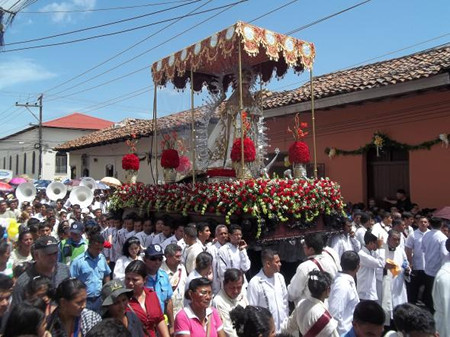 Nicaraguan's celebrating "La Purísima" | |
| "La purísima" es una celebración de "la Purísima Concepción de la Virgen María", cuyo día de celebración es el 8 de Diciembre! / Es una de las fiestas más grandes y importantes de Nicaragua! / Foto tomado de; tugentelatina.com | "La
Purísima" = Is a celebration of the "The Purest Conception of the
Virgin Maria," which is celebrated on the its feast-day every December
8. / This is one of Nicaragua's biggest holidays! / Photo from; tugentelatina.com |
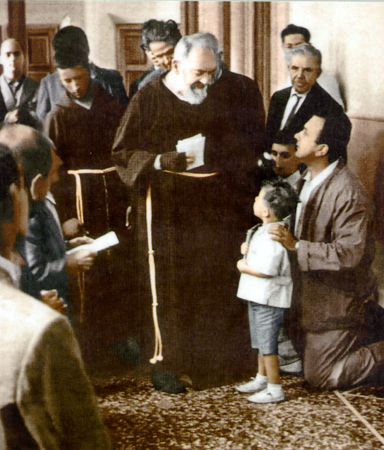 | |
| Una cita del "Padre Pio"; "No te preocupes por mañana, porque el mismo Padre Celestial que hoy cuida de usted, tendrá el mismo pensamiento por usted, mañana y siempre. / ¿Qué tiene que temer un niño, en los brazos de semejante padre? / Esté como niños, que casi nunca piensan en su futuro, ya que tienen alguien para pensar para ellos. / Son lo suficientemente fuerte simplemente por estar con su padre". / - St. Pio of Pietrelcina | A quote from "Padre Pio"; "Don’t worry about tomorrow because the very same Heavenly Father who takes care of you today will have the same thought tomorrow and always. . . / What does a child in the arms of such a father have to fear? / Be as children, who hardly ever think about their future as they have someone to think for them. / They are sufficiently strong just by being with their father." / - St. Pio of Pietrelcina |
| ||||||||||||||||||||||||||||||||||||||||||||||||||||||